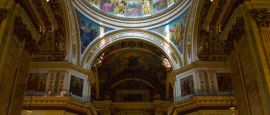Started in 1764 when Empress Catherine the Great acquired 225 paintings from Western Europe, Hermitage now has over three million works of art lavishly displayed in its six buildings. Five of the buildings (the Winter Palace, Small Hermitage, Old Hermitage, New Hermitage, and Hermitage Theatre) are open to the public. Highlights include works by Leonardo da Vinci, Michelangelo, Raphael, Titian, Rembrandt and Rubens. It would take more than five years to tour the Hermitage, spending just one minute at each exhibit and that is assuming that the museum opens at all hours and every day.
Things to see in St Petersburg
Tourist offices
Address: Sadovaya ulitsa 14/52, St Petersburg, 191023, Russia
Tel: +7 812 242 3909.
Opening Hours:
Mon-Sun 1000-1900
www.ispb.infoThe St Petersburg Tourist Information Bureau on Sadovaya ulitsa is a good first port of call for local information. They maintain several information kiosks around the city.
The St Petersburg Card (www.petersburgcard.com/en) gives free entrance to 50 local museums and attractions and it includes a rechargeable ‘e-purse’, which can be used to pay for tickets on the metro, buses, trolleybuses and trams. Passes last from two to seven days.
Modelled on St Basil's Cathedral in Moscow, this church was built on the spot where socialist radicals assassinated Emperor Alexander II on 1 March 1881. It’s crowned by a fantasy collection of tiled onion domes and has a stunningly restored interior of gleaming marble and glittering mosaics. The best views of the exterior are from across the canal, on naberezhnaya Kanala Griboedova.
Often overshadowed by the splendour of the Hermitage, these sprawling galleries contain the world's finest collection of Russian paintings, from 1,000-year-old icons to old masters and modern legends like Malevich, Kandinsky and Chagall. There is an additional charge for the galleries outside the Mikhailovsky Palace and Benois Wing, which open Monday, Wednesday and Friday to Sunday 1000-1800, plus Thursday 1300-2100.
Housed in the beautiful Shuvalovsky Palace, this auspicious museum is dedicated to the work of preeminent jeweller Carl Fabergé, famed for his intricate bejewelled eggs. It has the largest collection of pieces by the designer in the world with more than 4,000 works of decorative Russian art. Tours must be booked at least five days in advance.
This spectacular imperial cathedral, commissioned by Tsar Alexander I, is a engineering masterpiece on marshy ground west of Nevsky prospekt. Crowned by a gilded dome that rivals St Peter’s in the Vatican, the cathedral was completed in 1858 and it still dominates the St Petersburg skyline. The interiors are dazzling and the climb to the colonnade of the dome (accessible on a separate ticket) is rewarded by marvellous panoramic views.
Russia’s oldest state museum is centred on the cabinet of curiosities assembled by Peter the Great during his grand tour of Europe, though it’s the collection of physically abnormal foetuses preserved in alcohol that draws the crowds. It’s fascinating stuff, best reserved for visitors with strong stomachs and a scientific curiosity.
The first house built in St Petersburg was not a grand palace but a humble wooden cabin, from where Peter the Great supervised the construction of his grand imperial city. Now encased in a protective brick enclosure and furnished with period furniture, its spartan simplicity is a strange contrast to the grand cathedrals and palaces all around.
Built by Peter the Great in 1703 to defend the area from the Swedes, this fortress soon became a political prison. Famous inmates included Dostoevsky, Gorky and Trotsky, plus Peter's own son, Alexei. The bleak cells are now a museum, along with the Commandant's House where prisoners were tried. The highlight though is the soaring gold spire of the cathedral.
Launched in St Petersburg in 1900, the Cruiser Aurora served as a battleship in the Russo-Japanese War of 1904-5, before firing the shot that signalled the storming of the Winter Palace in 1917 and the beginning of Bolshevik rule. Refitted as a museum, you can see the crew's quarters and the gun that fired the historic shot.
This is a place of pilgrimage for the dwindling survivors of the 1941-44 siege of Leningrad, one Russia’s darkest hours. Under the gaze of a massive bronze of Mother Russia lie the mass graves of 500,000 St Petersburg citizens who starved to death in the Nazi blockade. The story of the suffering and endurance of the city is powerfully told in the Memorial Halls.
Do you have any Feedback about this page?
© 2025 Columbus Travel Media Ltd. All rights reserved. No part of this site may be reproduced without our written permission, click here for information on Columbus Content Solutions.








 You know where
You know where